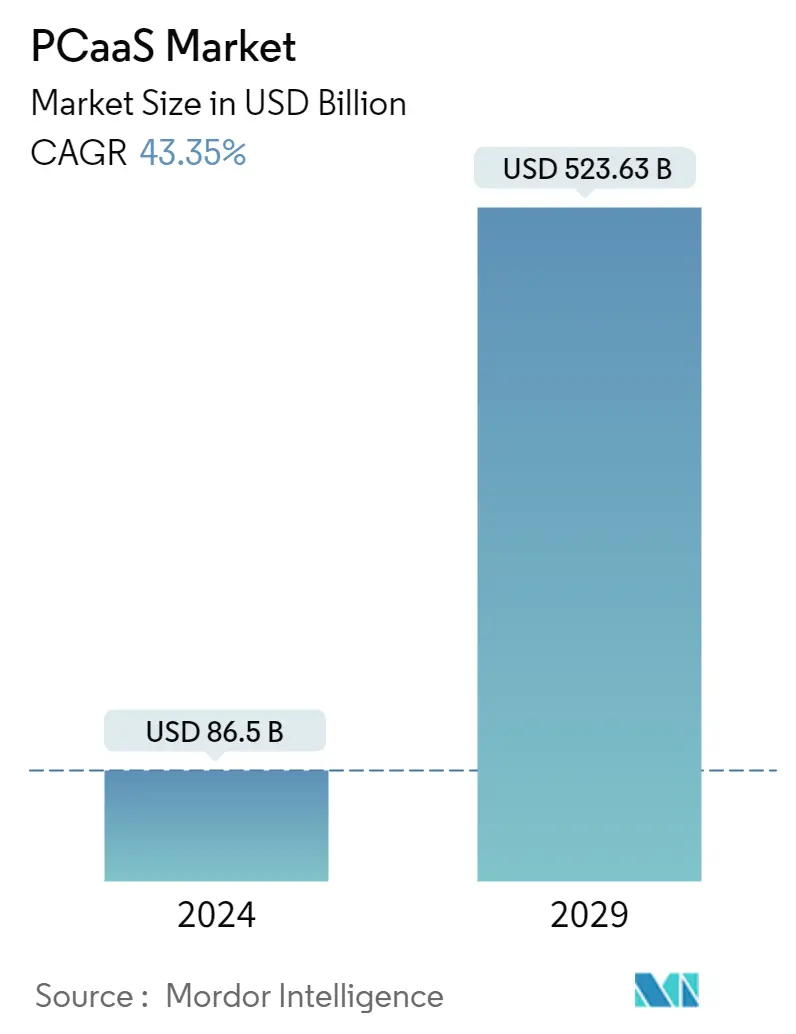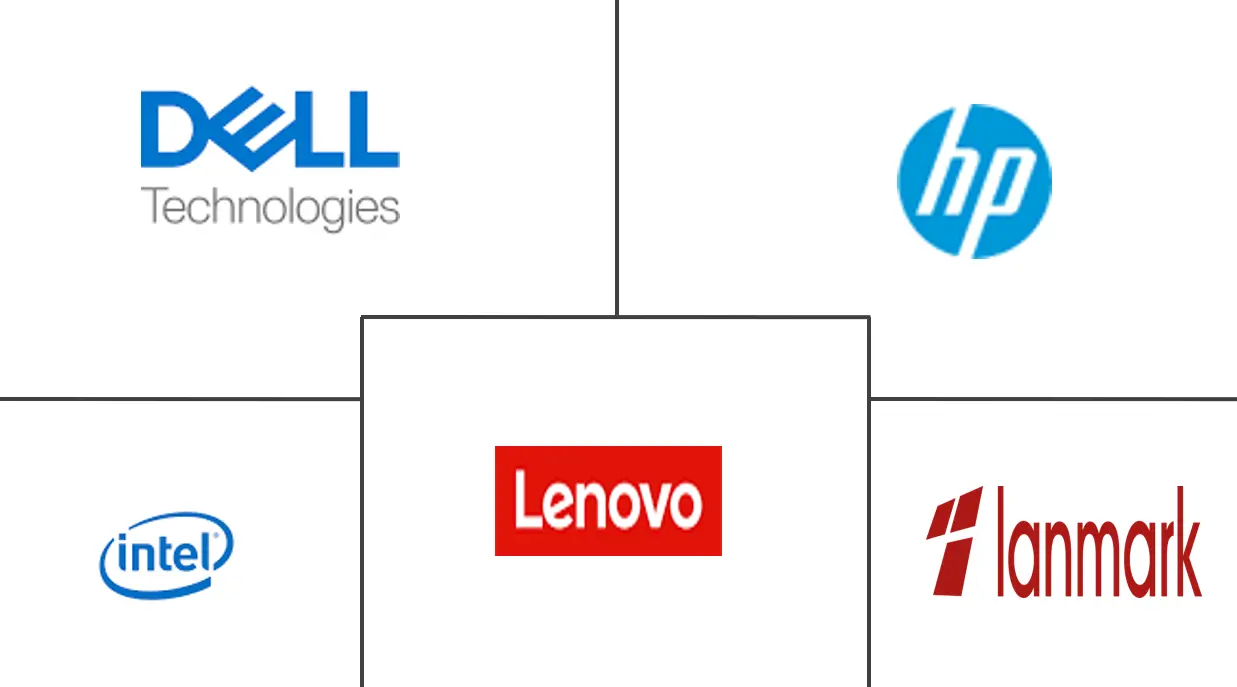Market Size of PCaaS Industry

| Study Period | 2019 - 2029 |
| Market Size (2024) | USD 86.50 Billion |
| Market Size (2029) | USD 523.63 Billion |
| CAGR (2024 - 2029) | 43.35 % |
| Fastest Growing Market | Asia-Pacific |
| Largest Market | North America |
Major Players
*Disclaimer: Major Players sorted in no particular order |
PC as a Service Market Analysis
The PCaaS Market size is estimated at USD 86.5 billion in 2024, and is expected to reach USD 523.63 billion by 2029, growing at a CAGR of 43.35% during the forecast period (2024-2029).
The increasing need to reduce IT staffing costs and workload and the adoption of PCaaS by small and medium-sized enterprises (SMEs) are the key factors driving demand in the market. Recently, HP Inc. presented a comprehensive set of PCaaS offerings for customers and channel partners, including the launch of DaaS, an evolution of PCaaS aimed at simplifying and speeding up IT management and thereby reducing IT staffing costs by providing a comprehensive, end-to-end solution for businesses.
- The increasing IT budget and focus on business support applications are the vital factors driving the market's growth. According to Spiceworks' Ziff Davis, 64% of enterprises (with more than 500 employees) planned to increase their IT budgets by the end of last year.Also, some of the major reasons for the IT budget increase include increased priority on IT projects (49%), a need to upgrade outdated IT infrastructure (47%), and increased security concerns (44%). Furthermore, by last year, 9% of the total software and hosted/cloud-based services budget was expected to be allocated for business support applications. The emphasis on improving business applications in line with an increase in IT budgets creates new opportunities for the PCaaS market.
- Efficiency plays a vital role in SMEs' IT expenditures. Owing to the benefits that PCaaS offers, the adoption of these solutions is high among SMEs. According to Intel, small business workers lose more than one workweek per year due to old PCs that use outdated technology. The PCaaS offering is expected to evade unnecessary costs related to efficiency, security, and workforce productivity. Such advantages will likely drive the demand for PCaaS in SMEs during the forecast period.
- An assessment done by Schneider Electric and Hartford Steam Boiler in the past year revealed that there are a large number of factors that contribute to equipment failure. These factors include environmental issues (8%), humidity (9%), and improper operations (9%), among the many factors responsible for the failures. In another survey of 200 executives conducted by Honeywell, approximately 42% admitted to operating equipment in an improper manner, resulting in equipment failure.Such scenarios indirectly add to the demand for PCaaS services, especially in the case of large organizations.
- Despite PCaaS improving employee flexibility, customer experience, and ROI, lack of product differentiation is a factor that affects the market's growth. Most of the players in the market offer similar benefits to their clients, which include monthly fixed-time payments, PC lifecycle support, and improved productivity, among others.
- With the growth in cloud-based desktop services during the COVID-19 pandemic situation, PCaaS packages have been highly efficient and cost-effective for supporting [work-from-home] employees, according to Pund-IT. Long-term, more people are likely to use PCaaS because of the strong digital transformation and the need to cut IT costs to keep businesses running.
PC as a Service Industry Segmentation
PC as a Service (PCaaS), in which a person or organization pays a monthly subscription fee to a vendor to lease endpoint hardware and management services, brings together the user's PC hardware, PC management tools, and PC support specialists.
The PCaaS Market report is segmented by Type (Hardware, Software, and Services), Deployment Type (Small and Medium-scale Organizations, Large Organizations), End-user (BFSI, Healthcare, Life Sciences, IT and Telecom, Government and Defense, Education), and Geography (North America, Europe, Asia Pacific, and Rest of the World).
The market sizes and forecasts are provided in terms of value (USD million) for all the above segments.
| By Type | |
| Hardware | |
| Software | |
| Services |
| By Deployment Type | |
| Small and Medium-scale Organizations | |
| Large Organizations |
| By End-user Industry | |
| BFSI | |
| Healthcare and Life Sciences | |
| IT and Telecom | |
| Government and Defense | |
| Education | |
| Other End-user Industries |
| By Geography | |
| North America | |
| Europe | |
| Asia Pacific | |
| Rest of the World |
PCaaS Market Size Summary
The PC as a Service (PCaaS) market is poised for significant growth, driven by the increasing demand from small and medium-sized enterprises (SMEs) seeking to reduce IT staffing costs and streamline operations. The adoption of PCaaS solutions is particularly high among SMEs due to the efficiency and cost-effectiveness they offer, helping businesses avoid unnecessary expenses related to outdated technology. The market is further bolstered by the rising IT budgets and a heightened focus on business support applications, which create new opportunities for PCaaS providers. The shift towards cloud-based desktop services, accelerated by the COVID-19 pandemic, has also contributed to the market's expansion, as businesses seek flexible and scalable solutions to support remote workforces.
In the United States, the PCaaS market benefits from the presence of major players like Dell, HP Inc., and Samsung, which continue to invest in technology development through research and development, strategic partnerships, and mergers and acquisitions. These companies offer attractive financing models and comprehensive service packages that appeal to the commercial sector, supporting the market's growth. The competitive landscape is intense, with companies like Lenovo and Dell Technologies enhancing their product offerings to meet the evolving needs of businesses. As digital transformation accelerates and the demand for cloud-based solutions increases, the PCaaS market is expected to expand significantly, with SMEs playing a crucial role in driving this growth.
PCaaS Market Size - Table of Contents
-
1. MARKET DYNAMICS
-
1.1 Market Overview
-
1.2 Market Drivers
-
1.2.1 Increasing Demand from Small and Medium-scale Organizations Due to Cost Benefits
-
1.2.2 Renewed Focus on Managed Service Providers
-
-
1.3 Market Restraints
-
1.3.1 Lack of Product Differentiation
-
-
1.4 Industry Attractiveness - Porter's Five Forces Analysis
-
1.4.1 Bargaining Power of Suppliers
-
1.4.2 Bargaining Power of Consumers
-
1.4.3 Threat of New Entrants
-
1.4.4 Threat of Substitutes
-
1.4.5 Intensity of Competitive Rivalry
-
-
1.5 Impact of COVID-19 on the Market
-
-
2. MARKET SEGMENTATION
-
2.1 By Type
-
2.1.1 Hardware
-
2.1.2 Software
-
2.1.3 Services
-
-
2.2 By Deployment Type
-
2.2.1 Small and Medium-scale Organizations
-
2.2.2 Large Organizations
-
-
2.3 By End-user Industry
-
2.3.1 BFSI
-
2.3.2 Healthcare and Life Sciences
-
2.3.3 IT and Telecom
-
2.3.4 Government and Defense
-
2.3.5 Education
-
2.3.6 Other End-user Industries
-
-
2.4 By Geography
-
2.4.1 North America
-
2.4.2 Europe
-
2.4.3 Asia Pacific
-
2.4.4 Rest of the World
-
-
PCaaS Market Size FAQs
How big is the PCaaS Market?
The PCaaS Market size is expected to reach USD 86.50 billion in 2024 and grow at a CAGR of 43.35% to reach USD 523.63 billion by 2029.
What is the current PCaaS Market size?
In 2024, the PCaaS Market size is expected to reach USD 86.50 billion.

